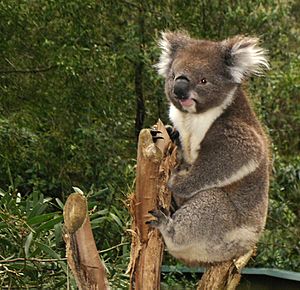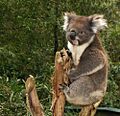Biriwal Bulga National Park facts for kids
Quick facts for kids Biriwal Bulga National ParkNew South Wales |
|
|---|---|
|
IUCN Category II (National Park)
|
|
| Established | 1999 |
| Area | 65.28 km2 (25.2 sq mi) |
| Managing authorities | NSW National Parks and Wildlife Service |
| See also | Protected areas of New South Wales |
Biriwal Bulga National Park is a special protected area in New South Wales, Australia. It's about 45 kilometers northwest of Taree and 60 kilometers west of Port Macquarie. This park is home to many different kinds of plants and animals. It also has important cultural sites for Indigenous Australians.
The park's landscape includes steep cliffs and varying soil types. It gets a lot of rain each year, which helps many native plants grow. The NSW National Parks and Wildlife Service manages the park. They have plans to protect its natural beauty and cultural history. These plans also allow for research and help keep koalas safe. They also work to control pests and prevent bushfires.
Contents
Where the Name Comes From
The name Biriwal Bulga comes from the Birpai or Biripi Indigenous Australians. These people have lived in this area for over 15,000 years. The Birpai people spoke the Birpai language. Other nearby tribes spoke a language called Gadjang.
Many campsites and old tools have been found in the park. This shows that Indigenous Australians lived here a long time ago. It's thought that between 800 and 1000 Indigenous Australians once lived in this park and the areas around it. They lived in small family groups, with the Winmurra people being one of the most well-known.
Park History
Europeans first explored the areas around Biriwal Bulga in the 1800s. But it wasn't until 1982 that they started finding things inside the park itself. This makes Biriwal Bulga National Park one of the newer parks discovered in the Port Macquarie area.
The park was once part of the Bulga State Forest Area. In the early 1900s, people used this forest for cutting down trees. They even planted pine trees here. In 1990, the government stopped all tree cutting to protect the environment. This led to the area becoming Biriwal Bulga National Park, which helps protect nature.
About the Park's Land
Biriwal Bulga National Park covers about 5,813 hectares (about 14,364 acres). It sits on the northern edge of the Bulga plateau. The land goes from 130 meters up to 670 meters high. The park's landscape has many hills and valleys. The most common rocks you'll find here are mudstone and shale.
The park gets a lot of rain, usually between 1300-1600mm each year. This rain can cause soil to wash away if there aren't enough plants covering the ground.
Not many people visit the park because it's hard to get to. There are no roads for regular cars or bike paths. The park also doesn't have any facilities or walking trails. If you want to find places to visit, you can go to nearby Tapin Tops National Park or Ellenborough Falls at Elands.
Weelah Nature Reserve
Weelah Nature Reserve is a small area of 37 hectares inside the park. It's in the southeast part of Biriwal Bulga National Park. This reserve has some of the last remaining rainforest on the Bulga Plateau. This makes it a very important place for research and protecting nature.
Plants and Animals
Animals of the Park
Seventy-four different kinds of animals have been seen in Biriwal Bulga National Park. Some of these animals are considered vulnerable, meaning they are at risk of becoming endangered. These include the powerful owl, glossy black cockatoo, fruit-dove, spotted-tailed quoll, and koala.
Koalas are the most common animals found in the park. There are different types of koalas that live here. They often move between the park and nearby areas. It's thought that about 500 to 1000 koalas live in the Biriwal Bulga region.
Plants of the Park
Sixteen types of plants have been recorded in Biriwal Bulga National Park. The main type of forest here is called dry sclerophyll forest. In the past, people cut down trees in the park for timber. This damaged the forests and disturbed the natural environment.
However, tree cutting stopped in the 1950s. Since then, most of the forest has grown back. The park is so well-preserved that it might even be added to the Central Eastern Rainforest Reserves of Australia (CERRA) World Heritage Area list. This list protects very important natural places around the world.
Until 2004, no threatened plant species were found in the park. The Plectranthus suaveolens is the only rare plant found here. The NSW Wildlife Services lists two plants as endangered: the vine (Cynanchum elegans) and the ground orchid (Diuris flavescens).
Waterways
Most of the rain that falls in Biriwal Bulga National Park flows into nearby creeks. These creeks eventually lead to the Hastings River. The Doyles River, which is about 6 kilometers long, is the main body of water near the park. It's on the park's southeastern border.
Inside the park, there are two main water collection areas: Green Gully Creek and Big Creek. The water that leaves the park helps supply water to farms downstream. It also partly supplies water to the town of Port Macquarie.
Environmental Challenges
Pests
Biriwal Bulga National Park has some animals that are considered pests. These animals can harm the park's natural environment. Wild dogs, foxes, pigs, and cats have been seen in the area. Wild dogs, especially dingoes, are a big threat to the koalas. They can hunt koalas that leave their trees.
Foxes and pigs can also damage the park's soil. Their movement can cause soil erosion, where dirt washes away with the water. This dirt can then flow into the park's waterways.
Besides animals, some plants and weeds also threaten the park. In the 1960s, pine trees were planted here as an experiment. Now, these pine trees are spreading outside their original area. If not controlled, they can harm the natural ecosystem. Other pest plants, like lantana, have also spread into the park from nearby trails.
Fires
Because the park has many dense forests, it can easily catch fire. These fires are a threat to the wet sclerophyll forests that are common in the park. If fires happen often, they can burn the rainforest and harm the many different plants and animals living there. The main type of fire in Biriwal Bulga National Park is a bushfire.
Biriwal Bulga National Park was affected by the big bushfires in Australia in 2019-2020. The fires burned from mid-December to mid-January. Heavy rain and thunderstorms helped firefighters control the fires in the park.
Bacteria
Some bacteria in the park can cause problems for the animals, especially koalas. One dangerous bacteria is called Chlamydia pecorum. This disease can make koalas very sick and even kill them. It spreads easily from one animal to another. Since koalas often move in and out of the park, this disease can spread in Biriwal Bulga. Park managers have plans to control this bacteria and protect the koala population.
How the Park is Managed
Biriwal Bulga National Park is a very important cultural place for Indigenous Australians. Any plans to protect the park must be discussed with members of the Biripi people. Their involvement helps make sure that Aboriginal heritage is protected in the park.
Currently, there are nine known sites in Biriwal Bulga that are important to the local Indigenous community. Two more possible sites are being looked into with help from the Indigenous community.
The NSW National Parks and Wildlife Service (NPWS) has plans to deal with pests in the park. They map out areas where there are many pest animals and plants. This helps them control the pests and keep them away from native species. They also focus on controlling the pine trees around the old plantation area. This stops them from spreading into the natural habitat.
Biriwal Bulga is also a special place for koala conservation. The park's land and environment help the koala population grow steadily. Since not many people visit, koalas can live peacefully. It's important to keep studying and monitoring the koalas. This helps make sure they are safe from diseases that could reduce their numbers.
The park's dense forests are a concern during bushfire seasons. To protect the park, methods like back-burning are used. This helps prevent big fires from destroying the ecosystem. The NSW National Parks and Wildlife Service works closely with local Rural Fire Services. They aim to keep the land free from large fires every 10 to 15 years.
To carry out these management plans, it's important to have easier access to the park. The NSW wildlife service plans to talk with neighbors of the park to create safe tracks. If these tracks are built, the park will set rules to make sure visitors don't disturb the local environment.
The NSW wildlife service wants to promote Biriwal Bulga as a remote place for visitors who like to be self-reliant in nature. They won't build new facilities in the park. Instead, visitors will be encouraged to use facilities in nearby areas. This information can be shared through signs or on the park's website. The services also plan to watch visitor activities. This ensures that everyone follows the rules for their safety and the park's safety. They might do surveys to see how many people visit and check if anyone leaves trash behind.
Images for kids
See also
 In Spanish: Parque nacional Biriwal Bulga para niños
In Spanish: Parque nacional Biriwal Bulga para niños




